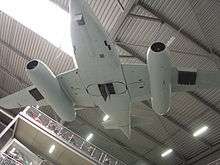
Air-to-air rocket
For air-to-air missiles, see Air to air missile.
An air-to-air rocket or air interception rocket is an unguided projectile fired from aircraft to engage other flying targets. They were used briefly in World War I to engage enemy observation balloons and in and after World War II to engage enemy bombers. Fighters were too maneuverable to be effectively engaged with rockets.
History
World War I
Rockets were used in World War I to engage observation balloons and airships. Success rates were low and the rockets were dangerous to handle in the early fighters built from highly flammable materials. By the end of the war they were replaced by the incendiary Pomeroy bullets. The Pomeroy bullet was developed to strike German Zeppelin airships, by igniting the hydrogen in the balloon. They did not always work. One of the notable rockets from World War I was the Le Prieur rocket which had a range of about 115 m (126 yd), limited by inaccuracy. It was first used in the Battle of Verdun.
Podcasts:

